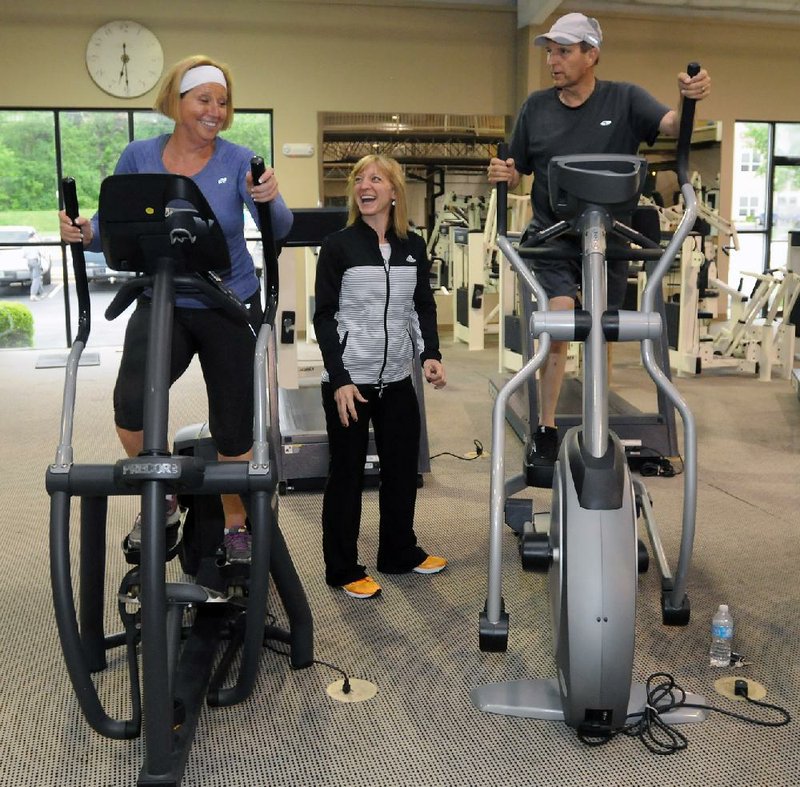ROGERS - Tom Johnson towels off after an hour-and-ahalf workout. The Fayetteville architect checks items off his exercise list: elliptical. Check.
Free weights. Check. Group therapy. Check.
There’s sweat dripping down his nose, and he barely has enough breath to answer questions for the nosy reporter who has trekked to the Northwest Arkansas Mercy Family YMCA to ask about his fitness regimen.
But that’s nothing compared to where Johnson has been.
Three years ago after being diagnosed with leukemia, Johnson abandoned his Fayetteville home to live in Houston and take daily treatments at M.D. Anderson Cancer Center.
“I went through an eight month process where they literally killed all my blood cells and replaced them with new bone marrow,” he says. “I went from having A-positive blood to O-positive blood.”
Johnson’s recovery has been arduous. “It’s been a couple of years of just trying to get back in the game again,” he says.
“I’m just now starting to feel good again.” And part of that can be attributed to his exercise program.
Sixty pounds lighter than he once was, Johnson works out with five other cancer survivors from around Northwest Arkansas and several of their relatives. They are part of the Rogers Y’s first session of LiveStrong at the YMCA, a 12-week exercise program for cancer survivors and their caregivers. Designed to help cancer survivors get their strength back after treatment, LiveStrong at the YMCA is a nationwide exercise program founded in September 2007 as part of a partnership between the LiveStrong Foundation and the YMCA of the USA.
The Rogers Y became a LiveStrong host last year through a nationwide contest hosted by the LiveStrong Foundation, making it one of 283 sites around the United States offering the program.
The Rogers club held pilot sessions for two groups of three from October to January, so survivors and instructors could test the plans. The first full session began in April and ended with graduation ceremonies Thursday. A second full session is set to start in the fall, with registration currently under way.
The program is open to all cancer survivors, regardless of whether they’ve been in remission for a day or 20 years. All that’s required is a doctor’s release. “We even had one survivor who was going through radiation during the pilot session,” says Ashton Caton, health and wellness director for the Rogers YMCA.
GETTING WITH THE PROGRAM
In order to participate in the LiveStrong at the YMCA program, survivors must meet Caton for an interview. It can be an emotional process for some.
“When I first came in for the interview, I found the instructors to be very personable,” says Claudia Joseph of Rogers, a four-year breast cancer survivor. “They actually wanted to know not only how I was doing physically, but also mentally and emotionally. I was really touched by that.”
The physical program begins with some exercise basics. “When they come in for the first time, we get them started on some easy cardio so they’re starting to get their heart rate up,” says instructor Cindy Velotta, herself a five year breast cancer survivor. “We start them off easy - usually just 15 or 20 minutes [of cardio].”
Survivors then start learning about weight training using machines. Arms, legs and core muscles get used to working against resistance during this teaching period. After a few weeks with the machines, participants move on to free weights.
Yoga ends each session of the twice-a-week exercise.
“We go very slowly because they might be sore or they might have injuries or other issues from the cancer or the surgeries they’ve had,” Velotta says.
Instructors including Velotta and Caton customize the exercise regimen for each participant depending on those issues and injuries - and depending on each survivor’s ability - and the program adheres to the American College of Sports Medicine exercise guidelines for cancer survivors.
“The program is individualized to each of these participants. Some of them have knee problems. Some of them have shoulder problems. So, we work with them on that,” Caton says. “It’s a personal training program, but it’s in a group setting for that emotional support.”
So, the exercise regimen for Bonnie Rountree of Rogers, a 12-year breast cancer survivor who worries about lymphedema, will look very different from the program for Karen Dineen, also of Rogers, a six-year breast cancer survivor who worked out regularly before joining LiveStrong at the YMCA.
“I like the leg exercises much more than I do the arm simply because, with my mastectomy, I had all the lymph nodes taken out,” Rountree says. “Even though I don’t have swelling in my arms, it does hurt.”
Dineen, on the other hand, excels at exercises that build her arm muscles, lifting twice as much weight as Rountree.
“Even though we may be at somewhat different fitness levels, the program works for all because we work at our own pace and level and we’re still all doing it together,” Dineen says. “They give us lots of different options for the same thing.”
At the end of the 12 weeks, participants get to make up their own exercise programs that incorporate their favorite exercises along with an invitation to return for help from LiveStrong instructors any time.
DEEPER HEALING
The ultimate goal of the LiveStrong program is added stamina and energy for cancer survivors, but it’s more than that, according to Maureen Pike, a specialist in Baltimore for the YMCA of the USA’s Chronic Disease Prevention Programs.
“LiveStrong at the YMCA participants have reported increased physical strength, endurance and energy, but the benefits extend far beyond the physical,” Pike explains. She points to supportive relationships, a safe exercise environment and a new sense of normalcy as just some of those benefits.
“When you’re done with your medical doctors, it’s like, ‘OK, now what do I do?’” Velotta says. “It’s good to have this other step where someone else is helping you back into your life.”
Joseph says the biggest thing the LiveStrong program has given her is hope.
“Cancer continues to [affect] you. You look at your body, and certain days it’s like everything is just going to continue to go downhill,” she says. “This program gives you hope that you can never give up on your body. Regardless of scars, you can still tone, and you can still feel good about who you are.”
For Rountree, benefits include self-confidence and a sense of being in control of her own health. “I feel like I’m making an improvement in my life, whereas previously doctors were trying to make an improvement in my life,” she says. “This is something that I can do on my own to build up my stamina.”
Dineen says she values not just the extra stamina, but also the camaraderie. “There’s something about being with people who’ve been through the same thing,” she says. “We sweat, we laugh and we cry together.”
For Penny Bellard of Fayetteville, LiveStrong at the YMCA provides the opportunity to deal with the aftermath of breast cancer treatments, but also with another recent diagnosis: rheumatoid arthritis.
“Three months ago, when I would stand up, I walked like a 90-year-old woman,” she says. “Even though some people might still think I walk like an old woman, I can move a whole lot better now than I could even a month ago.”
Bellard, who has been in remission from cancer a year and a half, exercises with her daughter, Ricci Wages of Fayetteville. She believes Wages has benefited not only by exercising with her, but also by hearing the stories told by other survivors in the group.
“It’s not just for us,” Bellard says. “It’s for the ones who went through it with us.”
ActiveStyle, Pages 23 on 06/24/2013


